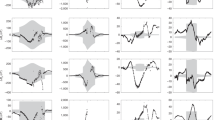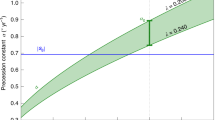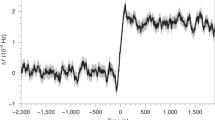Abstract
The rotation period of a gas giant's magnetic field (called the System III reference frame) is commonly used to infer its bulk rotation1. Saturn's dipole magnetic field is not tilted relative to its rotation axis (unlike Jupiter, Uranus and Neptune), so the surrogate measure of its long-wavelength (kilometric) radiation is currently used to fix the System III rotation period2. The period as measured now by the Cassini spacecraft is up to ∼7 min longer3 than the value of 10 h 39 min 24 s measured 28 years ago by Voyager2. Here we report a determination of Saturn's rotation period based on an analysis of potential vorticity. The resulting reference frame (which we call System IIIw) rotates with a period of 10 h 34 min 13 ± 20 s. This shifted reference frame is consistent with a pattern of alternating jets on Saturn that is more symmetrical between eastward and westward flow. This suggests that Saturn's winds are much more like those of Jupiter than hitherto believed4.
This is a preview of subscription content, access via your institution
Access options
Subscribe to this journal
Receive 51 print issues and online access
$199.00 per year
only $3.90 per issue
Buy this article
- Purchase on Springer Link
- Instant access to full article PDF
Prices may be subject to local taxes which are calculated during checkout


Similar content being viewed by others
References
Seidelman, P. K. & Devine, N. Evaluation of Jupiter's longitudes in System III (1965). Geophys. Res. Lett. 4, 65–68 (1977)
Desch, M. D. & Kaiser, M. L. Voyager measurement of the rotation period of Saturn’s magnetic field. Geophys. Res. Lett. 8, 253–256 (1981)
Gurnett, D. A. et al. The variable rotation period of the inner region of Saturn's plasma disk. Science 316, 442–445 (2007)
Aurnou, J. M. & Heimpel, M. H. Zonal jets in rotating convection with mixed mechanical boundary conditions. Icarus 169, 492–498 (2004)
Giampieri, G., Dougherty, M. K., Smith, E. J. & Russell, C. T. A regular period for Saturn's magnetic field that may track its internal rotation. Nature 441, 62–64 (2006)
Goldreich, P. & Farmer, A. J. Spontaneous axisymmetry breaking of the external magnetic field at Saturn. J. Geophys. Res. 112 A05225 10.1029/2006JA012163 (2007)
Anderson, J. D. & Schubert, G. Saturn’s gravitational field, internal rotation, and interior structure. Science 317, 1384–1387 (2007)
Dowling, T. E. A relationship between potential vorticity and zonal wind on Jupiter. J. Atmos. Sci. 50, 14–22 (1993)
Dowling, T. E. Dynamics of Jovian atmospheres. Annu. Rev. Fluid Mech. 27, 293–334 (1995)
Dowling, T. E. Estimate of Jupiter’s deep zonal wind profile from Shoemaker-Levy 9 data and Arnol’d’s second stability criterion. Icarus 117, 439–442 (1995)
Arnol’d, V. I. On an a priori estimate in the theory of hydrodynamical stability. [In Russian.] Izv. Vyssh. Ucheb. Zaved. Matematika 54, 3–5 (1966)
McIntyre, M. E. & Shepherd, T. G. An exact local conservation theorem for finite-amplitude disturbances to non-parallel shear flows with remarks on Hamiltonian structure and on Arnol’d stability theorems. J. Fluid Mech. 181, 527–565 (1987)
Charney, J. G. & Drazin, P. G. Propagation of planetary scale disturbances from the lower into the upper atmosphere. J. Geophys. Res. 66, 83–109 (1961)
Lian, Y. & Showman, A. P. Deep jets on gas-giant planets. Icarus 194, 597–615 (2008)
Ingersoll, A. P. & Pollard, D. Motion in the interiors and atmospheres of Jupiter and Saturn: scale analysis, anelastic equations, barotropic stability criterion. Icarus 52, 62–80 (1982)
Read, P. L. et al. Mapping potential-vorticity dynamics on Jupiter. I: Zonal-mean circulation from Cassini and Voyager 1 data. Q. J. R. Meteorol. Soc. 132, 1577–1603 (2006)
Read, P. L., Conrath, B. J., Fletcher, L. N., Gierasch, P. J. & Simon-Miller, A. A. Mapping potential vorticity dynamics on Saturn: zonal mean circulation from Cassini and Voyager data. Planet. Space. Sci. (in the press)
Stone, P. H. Baroclinic adjustment. J. Atmos. Sci. 35, 561–571 (1978)
Vasavada, A. R. & Showman, A. P. Jovian atmospheric dynamics: an update after Galileo and Cassini. Rev. Mod. Phys. 68, 1935–1996 (2005)
Read, P. L. et al. Dynamics of convectively driven banded jets in the laboratory. J. Atmos. Sci. 64, 4031–4052 (2007)
Stamp, A. P. & Dowling, T. E. Jupiter’s winds and Arnol’d’s second stability theorem: slowly moving waves and neutral stability. J. Geophys. Res. 98, 18847–18855 (1993)
Helled, R., Schubert, G. & Anderson, J. D. Empirical models of pressure and density in Saturn's interior: implications for the helium concentration, its depth dependence, and Saturn's precession rate. Icarus 199, 368–377 (2009)
Porco, C. C. et al. Cassini imaging of Jupiter’s atmosphere, satellites, and rings. Science 299, 1541–1547 (2003)
Acknowledgements
We are grateful to F. M. Flasar and the Cassini CIRS team for access to the data from which the potential vorticity profiles discussed here were computed. P.L.R. acknowledges support from the UK Science and Technology Facilities Council, T.E.D. acknowledges support from NASA's Planetary Atmospheres and Outer Planet Research Programs, and G.S. acknowledges support from NASA’s Planetary Atmospheres and Planetary Geology and Geophysics programs. We are grateful also to R. Helled for computing values of ρ0 and J2 for Saturn based on System IIIw.
Author Contributions P.L.R. obtained and processed the Cassini data, deriving potential vorticity and ω(α) profiles, and conducted the statistical analysis. T.E.D. made the original suggestion to investigate α(φ) and contributed to the interpretation of the results. G.S. provided additional insights into Saturn’s rotation, and all authors contributed to the text and discussion of results.
Author information
Authors and Affiliations
Corresponding author
PowerPoint slides
Rights and permissions
About this article
Cite this article
Read, P., Dowling, T. & Schubert, G. Saturn’s rotation period from its atmospheric planetary-wave configuration. Nature 460, 608–610 (2009). https://doi.org/10.1038/nature08194
Received:
Accepted:
Issue Date:
DOI: https://doi.org/10.1038/nature08194
This article is cited by
-
Rossby wave second harmonic generation observed in the middle atmosphere
Nature Communications (2022)
-
Uranus and Neptune are key to understand planets with hydrogen atmospheres
Experimental Astronomy (2022)
-
Rossby Waves in Astrophysics
Space Science Reviews (2021)
-
The turbulent dynamics of Jupiter’s and Saturn’s weather layers: order out of chaos?
Geoscience Letters (2020)
-
Uranus and Neptune: Origin, Evolution and Internal Structure
Space Science Reviews (2020)
Comments
By submitting a comment you agree to abide by our Terms and Community Guidelines. If you find something abusive or that does not comply with our terms or guidelines please flag it as inappropriate.



